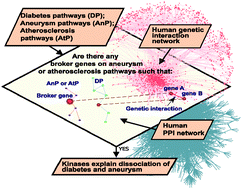Network wiring of pleiotropic kinases yields insight into protective role of diabetes on aneurysm
Abstract
Recent studies suggest a protective role of diabetes in the development of aneurysm, but the biological mechanisms behind this are still unknown. This type of association is not present in the case of diabetes and atherosclerosis despite similar risk factors for aneurysm and atherosclerosis. We postulate the existence of genes that disrupt the pathways needed for the onset of aneurysm in the presence of diabetes. Motivated by the significance of genetic interactions in understanding disease–disease associations, we tackle this problem by integrating protein–protein interaction and genetic interaction data, i.e., we examine the biological pathways related to the three diseases that contain genes involved in the following genetic interactions: one gene in a genetic interaction is part of a diabetes pathway, the other gene is part of an aneurysm, or an atherosclerosis pathway. We create a protein–protein interaction sub-network that contains disease pathways described above. We then use a “brokerage” measure – a topological measure that identifies proteins in this sub-network whose removal severely affects the interconnectedness of their neighbourhood, enabling such proteins to disrupt the pathway they are in. We identify a set of proteins with high brokerage values and find this set to be enriched in biological functions, including cell-matrix adhesion, which facilitates mechanisms that have already been suggested as possible causes of diabetes–aneurysm association. We further narrow down our set to 16 proteins that are involved in an aneurysm or an atherosclerosis pathway and are encoded by genes participating in genetic interactions with a gene in a diabetes pathway. This set is enriched in kinases and phosphorylation processes, with two pleiotropic kinases that are involved in both aneurysm and atherosclerosis pathways. Kinases can turn on or off proteins, explaining how functional changes of such proteins could result in the disruption of pathways. So if in an aneurysm-related pathway a gene is turned off, the onset of the disease could be prevented. However, mutations of pleiotropic genes could have effects only on one of the traits, which explains why pleiotropic kinases that are involved in both aneurysm and atherosclerosis pathways could disrupt aneurysm pathways explaining the reduced risk of aneurysm in diabetes patients, but not affect the atherosclerosis pathways.

- This article is part of the themed collection: Computational Integrative biology (IB)

 Please wait while we load your content...
Please wait while we load your content...